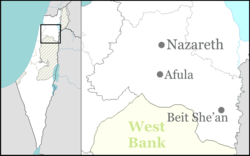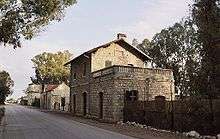Kfar Yehoshua
| Kfar Yehoshua כְּפַר יְהוֹשֻׁעַ | |
|---|---|
|
| |
 Kfar Yehoshua | |
| Coordinates: 32°41′0.95″N 35°9′14.04″E / 32.6835972°N 35.1539000°ECoordinates: 32°41′0.95″N 35°9′14.04″E / 32.6835972°N 35.1539000°E | |
| District | Northern |
| Council | Jezreel Valley |
| Affiliation | Moshavim Movement |
| Founded | 1927 |
| Population (2015)[1] | 1,107 |
| Name meaning | Joshua Village |

Kfar Yehoshua (Hebrew: כְּפַר יְהוֹשֻׁעַ, lit. Joshua's Village) is a moshav in northern Israel. Located between Carmel City and Nazareth, it falls under the jurisdiction of Jezreel Valley Regional Council. In 2015 it had a population of 2015.
History
Ottoman era
During the Ottoman era was here a Muslim village called Tell esh Shemmâm, meaning the melon or colocynth.[2] Moshe Dayan mentioned it as an example of "there is not one place built in this country which did not have a former Arab population".[3]
In 1881, the Palestine Exploration Fund's Survey of Western Palestine described Tel esh Shemmam a small artificial mound.[4]
British Mandate era
In the 1922 census of Palestine conducted by the British authorities, Tal al-Shammam had 71 inhabitants; 70 Muslims and 1 Melkite Christian.[5][6]
The moshav was founded in 1927,[7] based on an agreement reached in 1923 at a Histadrut committee meeting in Nahalal. In 1924, during the Shavuot holidays, the council met in order to clarify the ideological goal of combining the idea of the kibbutz and the moshav. In 1924, a contract for the purchase of land in the western Jezreel Valley was signed under the auspices of Yehoshua Hankin. In January 1927, the committee voted to name the village for Hankin. On March 3, 1927, the wooden hut of the former tenants of the railway station in Tel Shamam was brought to the hill of the village and the first families took up residence there.[8]
Kfar Yehoshua was one of 140 agricultural settlements designed by the German-Jewish architect Richard Kauffmann.[9] In the 1931 census Kfar Yehoshua had a population of 277; 32 Muslim and 245 Jews, in a total of 53 inhabited houses.[10] In 1945, the population was 620, all Jewish.[11][12]
Landmarks
A train station in Kfar Yehoshua operated for close to fifty years on the Jezreel Valley Railway, from the beginning of the 20th century to 1948. Seven stone buildings from this period have been restored by the Society for Preservation of Israel Heritage Sites, and original railroad tracks have been returned to the site.[13]
Notable residents
References
- ↑ "List of localities, in Alphabetical order" (PDF). Israel Central Bureau of Statistics. Retrieved 16 October 2016.
- ↑ Palmer, 1881, p. 117
- ↑ cited in Rogan and Shlaim, 2001, p. 207
- ↑ Conder and Kitchener, 1881, SWP I, p. 353
- ↑ Barron, 1923, Table XI, Sub-district of Haifa, p. 33
- ↑ Barron, 1923, Table XVI, p. 49
- ↑ Levy, Eyal (3 February 2012). בכפר יהושע המומים מההתאבדות של כוכב הריאליטי [Kfar Yehoshua residents stunned by suicide of reality star]. Nrg Maariv (in Hebrew). Retrieved 5 February 2012.
כפר יהושע הוקם ב-1927 ונמצא בעמק יזרעאל, שני קילומטרים דרומית לרמת ישי.
- ↑ Roads Lead to Kfar Yehoshua, Elie Shamir
- ↑ He planned Afula and Nahalal but who remembers, Haaretz
- ↑ Mills, 1932, p. 98
- ↑ Department of Statistics, 1945, p. 14
- ↑ Government of Palestine, Department of Statistics. Village Statistics, April, 1945. Quoted in Hadawi, 1970, p. 48
- ↑ In the footsteps of Israel's founding fathers
Bibliography
| Wikimedia Commons has media related to Kfar Yehoshua. |
- Barron, J. B., ed. (1923). Palestine: Report and General Abstracts of the Census of 1922. Government of Palestine.
- Conder, Claude Reignier; Kitchener, H. H. (1881). The Survey of Western Palestine: Memoirs of the Topography, Orography, Hydrography, and Archaeology. 1. London: Committee of the Palestine Exploration Fund.
- Department of Statistics (1945). Village Statistics, April, 1945. Government of Palestine.
- Hadawi, Sami (1970). "Village Statistics of 1945: A Classification of Land and Area ownership in Palestine". Palestine Liberation Organization Research Center. (p.49)
- Mills, E., ed. (1932). Census of Palestine 1931. Population of Villages, Towns and Administrative Areas. Jerusalem: Government of Palestine.
- Palmer, E. H. (1881). The Survey of Western Palestine: Arabic and English Name Lists Collected During the Survey by Lieutenants Conder and Kitchener, R. E. Transliterated and Explained by E.H. Palmer. Committee of the Palestine Exploration Fund.
- Rogan, Eugene L.; Shlaim, Avi (2001). The War for Palestine: Rewriting the History of 1948. Cambridge University Press. ISBN 0-521-79476-5.
External links
- Survey of Western Palestine, Map 5: IAA, Wikimedia commons